Vancouver
| City of Vancouver | |||
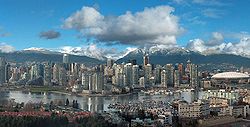 |
|||
|
|||
| Motto: "By Sea, Land, and Air We Prosper" | |||
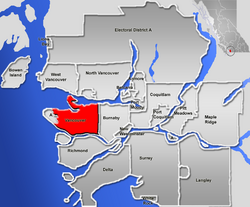 |
|||
| Coordinates: | |||
| Country | |||
|---|---|---|---|
| Province | |||
| Region | Lower Mainland | ||
| Regional District | Metro Vancouver | ||
| Incorporated | 1886 | ||
| Government | |||
| - Mayor | Sam Sullivan (Non-Partisan Association) | ||
| - Mayor-elect | Gregor Robertson (Vision Vancouver) | ||
| - City Council |
List of Councilors
|
||
| - MPs (Fed.) |
List of MPs
|
||
| - MLAs (Prov.) |
List of MLAs
|
||
| Area | |||
| - City | 114.67 km² (44.3 sq mi) | ||
| - Metro | 2,878.52 km² (1,111.4 sq mi) | ||
| Elevation | 2 m (7 ft) | ||
| Population (2006) | |||
| - City | 578,041 (Ranked 8th) | ||
| - Density | 5,335/km² (13,817.6/sq mi) | ||
| - Urban | 2,285,900 Metro Vancouver [1] | ||
| - Metro | 2,524,113 Lower Mainland [2] | ||
| - Demonym | Vancouverite | ||
| Time zone | PST (UTC−8) | ||
| - Summer (DST) | PDT (UTC−7) | ||
| Postal code span | V5K to V6Z | ||
| Area code(s) | 604, 778 | ||
| NTS Map | 092G03 | ||
| GNBC Code | JBRIK | ||
| Website: City of Vancouver | |||
Vancouver (pronounced /vænˈkuːvɚ/) is a coastal city and major seaport located in the Lower Mainland of southwestern British Columbia, Canada. It is the largest city in British Columbia and in the Pacific Northwest region. It is bounded by the Strait of Georgia, Burrard Inlet, the Fraser River, the city of Burnaby, and the University Endowment Lands. Vancouver is named after Captain George Vancouver, a British explorer. The name Vancouver itself originates from the Dutch "van Coevorden", denoting somebody from (in Dutch: "van") Coevorden, an old city in The Netherlands.[1]
The population of the city of Vancouver is 611,869[2] and the population of Metro Vancouver is 2,249,725 (2007 estimate).[3] Vancouver is also part of the slightly larger Lower Mainland metropolitan area which comprises a total population of 2,524,113.[3] This makes it the largest metropolitan area in Western Canada and the third largest in the country.[4] Vancouver is ethnically diverse, with 52% of city residents[5][6] and 43% of Metro residents[7] having a first language other than English.
Vancouver was first settled in the 1860s as a result of immigration caused by the Fraser Canyon Gold Rush, particularly from the United States, although many immigrants did not remain after the rush. The city developed rapidly from a small lumber mill town into a metropolitan centre following the arrival of the transcontinental railway in 1887. The Port of Vancouver became internationally significant after the completion of the Panama Canal, which reduced freight rates in the 1920s and made it viable to ship export-bound prairie grain west through Vancouver.[8] It has since become the busiest seaport in Canada, and exports more cargo than any other port in North America.[9]
The economy of Vancouver has traditionally relied on British Columbia's resource sectors: forestry, mining, fishing and agriculture. It has diversified over time, however, and Vancouver today has a large service industry, a growing tourism industry, and it has become the third-largest film production centre in North America after Los Angeles and New York City, earning it the nickname Hollywood North. An alternate term is Bollywood West.[10][11][12][13][14] Vancouver has had an expansion in high-tech industries, most notably video game development.
Vancouver is consistently ranked one of the three most livable cities in the world.[15][16][17][18] According to a 2008 report by Mercer Human Resource Consulting for example, Vancouver has the fourth highest quality of living in the world, after Zürich, Vienna and Geneva and ranked first in a survey by magazine 'The Economist'.[19][20] In 2007, according to Forbes, Vancouver had the 6th most overpriced real estate market in the world and second in North America after Los Angeles.[21][22] In 2007, Vancouver was ranked Canada's second most expensive city to live after Toronto and the 89th most expensive globally, and, in 2006, the 56th most expensive city in which to live among 143 major cities in the world.[23] In 2007, Vancouver was ranked as the 10th cleanest city in the world.[24]
The 2010 Winter Olympics will be held in Vancouver and nearby Whistler.[25][26][27]
Contents |
History
Archaeological records indicate that the presence of Aboriginal people in the Vancouver area dates back 4,500–9,000 years.[28][29] The city is located in the traditional territories of Skwxwú7mesh, Xwméthkwyiem, and Tseil-waututh peoples of the Coast Salish group.[30] They had villages in parts of present-day Vancouver, such as Stanley Park, False Creek, and along Burrard Inlet. Some of these still exist in North Vancouver, West Vancouver, and near Point Grey.
The first European to explore the coastline of present-day Point Grey and part of Burrard Inlet was José María Narváez of Spain, in 1791. George Vancouver explored the inner harbour of Burrard Inlet in 1792 and gave various places British names.[31]
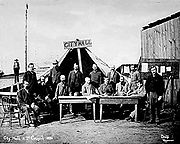
The explorer and North West Company trader Simon Fraser and his crew were the first Europeans known to have set foot on the site of the present-day city. In 1808, they traveled from the east, down the Fraser River perhaps as far as Point Grey, near the University of British Columbia.[33]
The Fraser Gold Rush of 1858 brought 25,000 men, mainly from California, to the mouth of the Fraser River and what would become Vancouver.[34][35][36] The first European settlement was established in 1862 at McLeery's Farm on the Fraser River, just east of the ancient village of Musqueam in what is now Marpole. A sawmill established at Moodyville (now the City of North Vancouver) in 1863 began the city's long relationship with lumbering. It was quickly followed by mills owned by Captain Edward Stamp on the south shore of the inlet. Stamp, who had begun lumbering in the Port Alberni area, first attempted to run a mill at Brockton Point, but difficult currents and reefs forced the relocation of the operation to a point near the foot of Gore Street, known as Hastings Mill. This became the nucleus around which Vancouver formed. The mill's central role in the city waned after the arrival of the Canadian Pacific Railway (CPR) in the 1880s. It nevertheless remained important to the local economy until it closed in the 1920s.[37]
Vancouver is among British Columbia's youngest cities.[38] The settlement of Gastown grew up quickly around the original makeshift tavern established by “Gassy” Jack Deighton in 1867 on the edge of the Hastings Mill property.[39][38] In 1870, the colonial government surveyed the settlement and laid out a townsite, renamed “Granville,” in honour of the then-British Secretary of State for the Colonies, Lord Granville. This site, with its natural harbour, was eventually selected as the terminus for the Canadian Pacific Railway to the disappointment of Port Moody, New Westminster and Victoria, all of which had vied to be the railhead. The building of the railway was among the preconditions for British Columbia joining Confederation in 1871.
The City of Vancouver was incorporated on 6 April 1886, the same year that the first transcontinental train arrived. The name, honouring George Vancouver, was chosen by CPR president William Van Horne, who arrived in Port Moody to establish the CPR terminus recommended by Henry John Cambie.[38] A massive "slash burn" (clearing fire) broke out of control on 13 June 1886, razing the entire city. It was quickly rebuilt, and the Vancouver Fire Department was established that same year.[37] From a settlement of 1,000 people in 1881, Vancouver's population grew to over 20,000 by the turn of the century and 100,000 by 1911.[40]
During the 1898 Klondike Gold Rush, Vancouver merchants sold a great deal of equipment to prospectors.[34] One of those merchants, Charles Woodward, had opened the first Woodward's store at what is now Cordova and Abbott Streets in 1892 and, along with Spencer's (later T. Eaton & Co. at Hastings & Richards Streets) and the Hudson's Bay Company (at Georgia & Granville Streets) department stores, formed the dominant core of the city's retail sector for decades.[41]
The economy of early Vancouver was dominated by large companies such as the CPR, which had the capital needed for the rapid development of the new city. Some manufacturing did develop, but the resource sector was the backbone of Vancouver's economy, initially with logging, and later with exports moved through the seaport, where commercial traffic constituted the largest economic sector in Vancouver by the 1930s.[42]
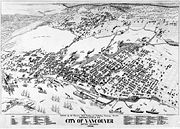
The dominance of the economy by big business was accompanied by an often militant labour movement. The first major sympathy strike was in 1903 when railway employees struck against the CPR for union recognition. Labour leader Frank Rogers was killed while picketing at the docks by CPR police during that strike, becoming the British Columbia movement's first martyr.[43] Canada's first general strike occurred following the death of another labour leader, Ginger Goodwin, in 1918, at the Cumberland coal mines on Vancouver Island.[44] A lull in industrial tensions through the later 1920s came to an abrupt end with the Great Depression. Most of the 1930s strikes were led by Communist Party organizers.[45] That strike wave peaked in 1935 when unemployed men flooded the city to protest conditions in the relief camps run by the military in remote areas throughout the province. After two tense months of daily and disruptive protesting, the relief camp strikers decided to take their grievances to the federal government and embarked on the On-to-Ottawa Trek,[46] but their commandeered train was met by a gatling gun at Hatzic, just east of Mission City, and the strikers arrested and interned in work camps for the duration of the Depression.[47]
Other social movements, such as the first-wave feminist, moral reform, and temperance movements were also influential in Vancouver's development. Mary Ellen Smith, a Vancouver suffragist and prohibitionist, became the first woman elected to a provincial legislature in Canada in 1918.[48] Alcohol prohibition began in the First World War and lasted until 1921, when the provincial government established its control over alcohol sales, which still persists today.[49] Canada's first drug law came about following an inquiry conducted by the federal Minister of Labour and future Prime Minister, William Lyon Mackenzie King. King was sent to investigate damages claims resulting from a riot when the Asiatic Exclusion League led a rampage through Chinatown and Japantown. Two of the claimants were opium manufacturers, and after further investigation, King found that white women were reportedly frequenting opium dens as well as Chinese men. A federal law banning the manufacture, sale, and importation of opium for non-medicinal purposes was soon passed based on these revelations.[50]
Amalgamation with Point Grey and South Vancouver gave the city its final contours not long before taking its place as the third largest metropolis in the country. As of 1 January 1929, the population of the enlarged Vancouver was 228,193 and it filled the entire peninsula between the Burrard Inlet and the Fraser River.[51]
Geography and climate
- Further information: Bodies of water in Vancouver, Climate of Vancouver, and Lower Mainland Ecoregion
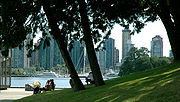
The original vegetation of most of Vancouver and its suburbs was dense temperate rain forest, consisting of conifers with scattered pockets of maple and alder, as well as large areas of swampland (even in upland areas, due to poor drainage).[52][53]
The conifers were a typical coastal British Columbia mix of Douglas-fir, Western red cedar and Western Hemlock;[54] thought to have been the greatest concentration of the largest of these trees on the entire British Columbia Coast. Only in Seattle's Elliott Bay did the trees rival those of Burrard Inlet and English Bay in size. The largest trees in Vancouver's old-growth forest were in the Gastown area, where the first logging occurred, and on the south slopes of False Creek and English Bay, especially around Jericho Beach. The forest in Stanley Park is mostly second and third growth, and evidence of old-fashioned logging techniques such as springboard notches can still be seen there.

A diverse collection of plants and trees were imported from other parts of the continent and from points across the Pacific, and can be found growing throughout Vancouver and the Lower Mainland. Various species of palm trees have proven hardy in this climate and are an occasional sight, as are large numbers of other exotic trees such as the monkey puzzle tree, the Japanese Maple, and various flowering exotics such as magnolias, azaleas, and rhododendrons. Many rhododendrons have grown to immense sizes, as have other species imported from harsher climates in Eastern Canada or Europe. The native Douglas Maple can also attain a tremendous size. Many streets in the city, covering whole areas, are lined with flowering varieties of Japanese cherry trees that were donated by Japan, starting in the 1930s, and flowering for weeks at the opening of spring each year. Other areas have streets lined in flowering chestnut, horse chestnut. and other decorative shade trees.[55] Certain areas of West Vancouver that have the right soil requirements are home to the Arbutus menziesii, Canada's only broad-leaved evergreen tree.
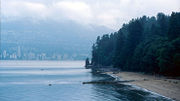
Vancouver has an area of 114 square kilometres (44 sq mi), including both flat and hilly ground. Vancouver is adjacent to the Strait of Georgia, a body of water that is shielded from the Pacific Ocean by Vancouver Island. It is in the Pacific Time Zone (UTC−8) and the Pacific Maritime Ecozone.[56] The city itself forms part of the Burrard Peninsula, lying between Burrard Inlet to the north and the Fraser River to the south. Vancouver is not on nearby Vancouver Island. However, both the island and the city (as well as Vancouver, Washington) are named after Royal Navy Captain George Vancouver.
Vancouver is renowned for its scenery and has one of the largest urban parks in North America, Stanley Park.[57] The North Shore Mountains dominate the cityscape, and on a clear day scenic vistas include the snow-capped volcano Mount Baker in the State of Washington to the southeast, Vancouver Island across the Strait of Georgia to the west and southwest, and the Sunshine Coast to the northwest.[58]
| for Vancouver | |||||||||||||||||||||||||||||||||||||||||||||||
|---|---|---|---|---|---|---|---|---|---|---|---|---|---|---|---|---|---|---|---|---|---|---|---|---|---|---|---|---|---|---|---|---|---|---|---|---|---|---|---|---|---|---|---|---|---|---|---|
| J | F | M | A | M | J | J | A | S | O | N | D | ||||||||||||||||||||||||||||||||||||
|
154
6
1
|
123
8
2
|
114
10
3
|
84
13
5
|
68
17
8
|
55
19
11
|
40
22
13
|
39
22
13
|
54
19
11
|
113
14
7
|
181
9
3
|
176
6
1
|
||||||||||||||||||||||||||||||||||||
| temperatures in °C precipitation totals in mm source: YVR |
|||||||||||||||||||||||||||||||||||||||||||||||
|
Imperial conversion
|
|||||||||||||||||||||||||||||||||||||||||||||||
Vancouver's climate is unusually temperate by Canadian standards; its winters are the fourth warmest of Canadian cities monitored by Environment Canada after nearby Victoria, Nanaimo, and Duncan, all of which are on Vancouver Island.[59] Vancouver has daily minimum temperatures falling below 0 °C (32 °F) on an average of 46 days per year and below −10 °C (14.0 °F) on only two days per year. The average annual precipitation is about 1,219 millimetres (48.0 in), though this varies dramatically throughout the city due to the topography.[58] Summer months are quite sunny with moderate temperatures, tempered by sea breezes. The daily maximum averages 22 °C (72 °F) in July and August, with highs occasionally reaching 30 °C (86 °F).[60] The summer months are often very dry, resulting in moderate drought conditions a few months of the year. In contrast, winter is a rainy season with more than half of all winter days receiving measurable precipitation. On average, snow falls on only eleven days per year, with only three days receiving 6 centimetres (2.4 in) or more.
While the number of cars in Vancouver proper has been steadily rising with population growth, the rate of car ownership and the average distance driven by daily commuters have fallen since the early 1990s.[61][62] Vancouver is the only major Canadian city with these trends. Despite the fact that the journey time per vehicle has increased by one third and growing traffic mass, there are 7% fewer cars making trips into the downtown core.[61] Residents have been more inclined to live in areas closer to their interests, or use more energy-efficient means of travel, such as mass transit and cycling. This is, in part, the result of a push by city planners for a solution to traffic problems and pro-environment campaigns. Transportation demand management policies have imposed restrictions on drivers making it more difficult and expensive to commute while introducing more benefits for non-drivers.[61]
Demographics
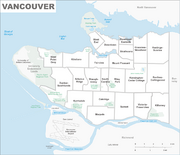
City planners in the late 1950s and 1960s deliberately encouraged the development of high-rise residential towers in Vancouver's West End of downtown, resulting in a compact urban core amenable to public transit, cycling, and pedestrian traffic. Vancouver's population density on the downtown peninsula is 121 people per hectare (or 49 people per acre), according to the 2001 census.[63] The city continues to pursue policies intended to increase density as an alternative to sprawl, such as Mayor Sam Sullivan's EcoDensity — an initiative to create quality and high density areas in the city, while making property ownership more economical. The plan also calls for the increased construction of community centres, parks, and cultural facilities.[64]
Vancouver has been called a "city of neighbourhoods", each with a distinct character and ethnic mix.[65] People of English, Scottish, and Irish origins were historically the largest ethnic groups in the city,[66] and elements of British society and culture are still highly visible in some areas, particularly South Granville and Kerrisdale. The Chinese are by far the largest visible ethnic group in the city, and Vancouver has one of the most diverse Chinese-speaking communities, with several Chinese dialects being represented, including Cantonese and Mandarin.[67][37] There are also some neighbourhoods with high concentrations of single ethnic groups, such as the Punjabi Market, Little Italy, Greektown, and Japantown. Bilingual street signs can be seen in various neighbourhoods, including Chinatown and the Punjabi Market.
In the 1980s, an influx of immigrants from Hong Kong in anticipation of the transfer of that former colony's sovereignty from the United Kingdom to China combined with an increasing number of immigrants from mainland China and previous immigrants from Taiwan to create one of the largest concentrations of ethnic Chinese residents in North America.
This influx of Asian immigrants continued a tradition of immigration from around the world that had already established Vancouver as the second most popular destination for immigrants in Canada (after Toronto).[68] Other significant Asian ethnic groups in Vancouver are South Asian (mostly Punjabi, usually referred to as Indo-Canadian), Vietnamese, Filipino, Indonesian, Korean, Cambodian, and Japanese. It has a growing Latin American population, many from Peru, Ecuador and more recently, Mexico.
Prior to the Hong Kong influx of the 1990s, the largest non-British ethnic groups in the city were Irish and German, followed by Scandinavian, Italian, Ukranian and the historical Chinese population. From the mid 1950s until the 1980s, many Portuguese immigrants came to Vancouver and the city now has the third largest Portuguese population in Canada after Toronto and Montreal. Less numerous minorities, such as newly-arrived Eastern Europeans (in addition to the aforementioned Ukrainians), are also a feature of the city's ethnic landscape.
There is also a sizeable aboriginal community in Vancouver as well as in the surrounding metropolitan region, with the result that Vancouver constitutes the largest native community in the province.[69]
Vancouver has a substantial gay community, and British Columbia was the second Canadian jurisdiction to legalize same-sex marriage as a constitutional right, shortly after Ontario.[70] The downtown area around Davie Street is home to most of the city's gay clubs and bars and is known as Davie Village. Every year Vancouver holds one of the country's largest gay pride parades.[71]
Population growth
The following table and graph show the population growth of the City of Vancouver (not including Point Grey and South Vancouver before 1929) and the metropolitan area using census data of Statistics Canada.[72]
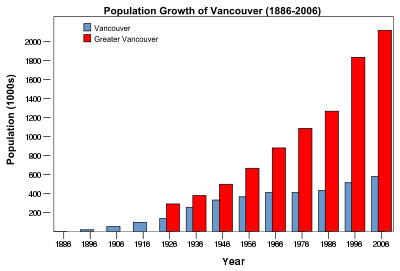
| Year | Vancouver | Metro |
|---|---|---|
| 1891 | 13,709 | 21,887 |
| 1901 | 26,133 | 42,926 |
| 1911 | 100,401 | 164,020 |
| 1921 | 117,217 | 232,597 |
| 1931 | 246,593 | 347,709 |
| 1941 | 275,353 | 393,898 |
| 1951 | 344,833 | 562,462 |
| 1956 | 365,844 | 665,564 |
| 1961 | 384,522 | 790,741 |
| 1966 | 410,375 | 892,853 |
| 1971 | 426,256 | 1,028,334 |
| 1976 | 410,188 | 1,085,242 |
| 1981 | 414,281 | 1,169,831 |
| 1986 | 431,147 | 1,266,152 |
| 1991 | 471,644 | 1,602,590 |
| 1996 | 514,008 | 1,831,665 |
| 2001 | 545,671 | 1,986,965 |
| 2006 | 578,041 | 2,116,581 |
| 2007 | 611,869 | 2,249,725 |
Economy

With its location on the Pacific Rim and at the western terminus of Canada's transcontinental highway and rail routes, Vancouver is one of the nation's largest industrial centres.[58]
The Port of Vancouver, Canada's largest and most diversified, does more than C$43 billion in trade with over 90 countries annually. Port activities generate $4 billion in gross domestic product and $8.9 billion in economic output.[73] Vancouver is also the headquarters of forest product and mining companies. In recent years, Vancouver has become an increasingly important centre for software development, biotechnology and a vibrant film industry.
The city's scenic location makes it a major tourist destination. Visitors come for the city's gardens, Stanley Park, Queen Elizabeth Park, and the mountains, ocean, forest and parklands surrounding the city. The numerous beaches, parks, waterfronts, and mountain backdrop, combined with its cultural and multi-ethnic character, all contribute to its unique appeal and style for tourists. Over a million people annually pass through Vancouver en route to a cruise ship vacation, usually to Alaska.[74]
Vancouver can be an expensive city, with the highest housing prices in Canada. Several 2006 studies rank Vancouver as having the least affordable housing in Canada, ranking 13th least affordable in the world, up from 15th in 2005.[75][76][77] The city has adopted various strategies to reduce housing costs, including cooperative housing, legalized secondary suites, increased density and smart growth. A significant number of the city's residents are affluent, a perception reinforced by the number of luxury vehicles on city streets and cost of real estate. As of mid-2007, the average two-storey home in Vancouver sells for $757,750, compared with $467,742 in Toronto and $322,853 in Calgary, the next most expensive major cities in Canada.[78] More recently, real estate indexes have put the average price of a Vancouver home at just under $700,000.[79]
A major and ongoing downtown condominium construction boom began in the late 1990s, financed in large part by a huge flow of capital from Hong Kong immigrants prior to the 1997 hand-over to China.[80] High-rise residential developments from this period now dominate the Yaletown and Coal Harbour districts of the downtown peninsula, and also cluster around some of the SkyTrain stations on the east side of the city.
The city has been selected to co-host the 2010 Winter Olympics, which is influencing economic development. Concern has been expressed that Vancouver's increasing homelessness problem may be exacerbated by the Olympics because owners of single room occupancy hotels, which house many of the city's lowest income residents, have begun converting their properties in order to attract higher income residents and tourists.[81] Another significant international event, the 1986 World Exposition, was held in Vancouver. It was the last World's Fair held in North America and was considered a success, receiving 20,111,578 visits. Several Vancouver landmarks date from that period, including the SkyTrain public transit system, the Plaza of Nations, and Canada Place.[82]
Government
Vancouver, unlike other British Columbia municipalities, is incorporated under the Vancouver Charter.[83] The legislation, passed in 1953, supersedes the Vancouver Incorporation Act, 1921 and grants the city more and different powers than other communities possess under BC's Municipalities Act.
The civic government has been dominated by the centre-right Non-Partisan Association (NPA) since the Second World War, albeit with some significant centre-left interludes.[37] The NPA's Sam Sullivan was elected mayor of Vancouver in November 2005, signaling the party's return to power after a social democratic slate swept the previous election. The NPA fractured over the issue of drug policy in 2002, facilitating a landslide victory for the Coalition of Progressive Electors on a harm reduction platform. Subsequently, North America's first safe injection site was opened for the significant number of intravenous heroin users in the city.
Vancouver is governed by the ten-member Vancouver City Council, a nine-member School Board, and a seven-member Parks Board, all elected for three-year terms through an at-large system. Historically, in all levels of government, the more affluent west side of Vancouver has voted along conservative or liberal lines while the eastern side of the city has voted along left-wing lines.[84] This was reaffirmed with the results of the 2005 provincial election and the 2006 federal election.

Though polarized, a political consensus has emerged in Vancouver around a number of issues. Protection of urban parks, a focus on the development of rapid transit as opposed to a freeway system, a harm reduction approach to illegal drug use, and a general concern about community-based development are examples of policies that have come to have broad support across the political spectrum in Vancouver.
Larry Campbell's election as mayor in 2002 was in part due to his willingness to champion alternative interventions for drug issues, such as supervised injection sites. The city has adopted a Four Pillars Drug Strategy, which combines harm reduction (e.g. needle exchanges, supervised injection sites) with treatment, enforcement, and prevention.[85] The strategy is largely a response to the endemic HIV and hepatitis C among injection drug users in the city's Downtown Eastside neighbourhood. The area is characterized by entrenched poverty, and consequently is home to the "low track" street sex trade and a bustling "open air" street drug market, which gave rise to a significant AIDS epidemic in the 1990s. Some community and professional groups — such as From Grief to Action and Keeping the Door Open — are fostering public dialogue in the city about further alternatives to current drug policies.[86][87]
Campbell chose not to run for re-election, and was subsequently appointed to the Senate of Canada. In the 2005 Municipal Election, the City Council swung back to the right after a term dominated by the leftist Coalition of Progressive Electors (COPE). NPA mayoral candidate Sam Sullivan narrowly defeated Jim Green for the position of mayor and was joined by five of his party's members on Council. The centrist Vision Vancouver (VVN) brought four members to Council, with the final seat going to COPE. The NPA also won six of nine School Board seats and five of seven Parks Board seats, while the remaining Board seats were won by COPE.[88]
Provincial representation
In the Legislative Assembly of British Columbia, Vancouver is represented by ten Members of the Legislative Assembly (MLAs), which includes Gordon Campbell, the current Premier. In the 2005 provincial election, the BC Liberal Party and the BC New Democratic Party each won five seats.
Federal representation
In the Canadian House of Commons, Vancouver is represented by five Members of Parliament. In the 2004 federal elections, the Liberal Party of Canada won four seats and the federal New Democratic Party (NDP) one. In the 2006 federal elections, all the same Members of Parliament were re-elected. However, on 6 February 2006, David Emerson of Vancouver Kingsway defected to the Conservative Party, giving the Conservatives one seat in Vancouver. In the 2008 federal election, the NDP took the Vancouver Kingsway seat vacated by Emerson, giving the NDP two seats to the Liberals' three.
Policing

While most of the Lower Mainland is policed by the Royal Canadian Mounted Police's "E" Division, Vancouver has its own city police force (as do New Westminster, West Vancouver, Delta, and Port Moody), with a strength of 1,174 sworn members and an operating budget of almost $150 million (in 2005 figures).[90][91][92] Over 16% of the city's budget was spent on police protection in 2005.[93]
The Vancouver Police has numerous operational divisions, including a bicycle squad, a marine squad, and a dog squad. It also has a mounted squad, used primarily to patrol Stanley Park and occasionally the Downtown Eastside and West End, as well as for crowd control.[94] The police work in conjunction with civilian and volunteer run Community Police Centres.[95] In 2006, the police department established its own Counter Terrorism Unit, which led to speculation of a rift between the Vancouver Police and the RCMP because the latter normally handles national security matters.[96][97] In 2005, a new transit police force, the Greater Vancouver Transportation Authority Police Service (now South Coast British Columbia Transportation Authority Police Service), was established with full police powers.
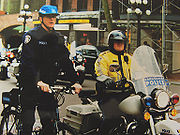
Although it is illegal, Vancouver police generally do not arrest people for possessing small amounts of marijuana.[98] In 2000 the Vancouver Police Department established a specialized drug squad, "Growbusters," to carry out an aggressive campaign against the city's estimated 4,000 hydroponic marijuana growing operations (or grow-ops) in residential areas.[99] As with other law enforcement campaigns targeting marijuana this initiative has been sharply criticized.[100]
As of 2005, Vancouver had the fourth highest crime rate among Canada's 27 census metropolitan areas.[101] However, as with other Canadian cities, the over-all crime rate has been falling "dramatically."[102][101] Vancouver's property crime rate is particularly high, ranking among the highest for major North American cities.[103] But even property crime dropped 10.5% between 2004 and 2005, according the Vancouver Police.[104] Metro Vancouver has the highest rate of gun-related violent crime of any major metropolitan region in Canada, according to a new Statistics Canada study. There were 45.3 violent offences involving guns for every 100,000 people in Metro Vancouver, slightly higher than Toronto at 40.4 but far above the national average of 27.5, says the report, which is based on police-reported data from 2006.[105]
Vancouver plays host to special events such as the Asia-Pacific Economic Cooperation conference, the Clinton-Yeltsin Summit or the Symphony of Fire fireworks show that require significant policing. The 1994 Stanley Cup riot overwhelmed police and injured up to 200 people.[106]
Transportation
- See also: List of Vancouver roads
Vancouver's streetcar system began on 28 June 1890 and ran from the (first) Granville Street Bridge to Westminster Avenue (now Main Street). Less than a year later, the Westminster and Vancouver Tramway Company began operating Canada's first interurban line between the two cities, which encouraged residential neighbourhoods outside the central core to develop.[107] The British Columbia Electric Railway became the company that operated the urban and interurban rail system, until 1958 when its last vestiges were dismantled in favour of "trackless" trolley and gasoline/diesel buses.[108] Vancouver currently has the second largest trolley bus fleet in North America after San Francisco.
City councils, as part of a long term plan, prohibited the construction of freeways in the 1980s.[109] The only major freeway within city limits is Highway 1, which passes through the north-eastern corner of the city.

South Coast British Columbia Transportation Authority (TransLink), the Metro Vancouver transportation authority, is responsible for roads and public transportation within the region. It provides a bus service, B-Line Rapid Bus Service (two of the three B-Lines run in Vancouver with two more B-Lines by 2008), a foot passenger and bicycle ferry service (known as SeaBus), a two-line automated light rail service called SkyTrain, and West Coast Express commuter rail.[110]
Changes are being made to the regional transportation network as part of the Gateway Program. Current projects include the Canada Line, a rapid-transit line that will connect Vancouver International Airport and the neighbouring city of Richmond with the existing Skytrain system. There is also planning going forward to extend the SkyTrain Millennium Line west to UBC as a subway under Broadway and capacity upgrades and an extension to the Expo Line. Many other road projects will be completed within the next few years, including the Golden Ears Bridge.
Inter-city passenger rail service is operated from Pacific Central Station by VIA Rail to points east; Amtrak Cascades to Seattle, Washington; and Rocky Mountaineer rail tour routes.
Small passenger ferries operating in False Creek provide commuter service to Granville Island, Downtown Vancouver and Kitsilano.
Vancouver is served by Vancouver International Airport (YVR), located on Sea Island in the City of Richmond, immediately south of Vancouver. Vancouver's airport is Canada's second busiest airport, and the second largest gateway on the west coast of North America for international passengers. HeliJet and three float plane companies Salt Spring Air, Harbour Air and West Coast Air operate scheduled air service from Vancouver harbour and YVR south terminal. The city is also served by two BC Ferry terminals. One is to the northwest at Horseshoe Bay, West Vancouver, and the other is to the south, at Tsawwassen (in Delta).
Education
Schools
Vancouver is served by School District 39 Vancouver, the second largest school district in British Columbia.[111] As in other parts of the province, numerous independent schools are also eligible for partial provincial funding — this includes religious schools, non-denominational schools, and special-needs schools, most of which also charge tuition. Vancouver also includes three schools that are part of the province-wide Conseil scolaire francophone de la Colombie-Britannique (CSF), the Francophone public school district.
Universities and colleges
The two major public universities in the Lower Mainland, the University of British Columbia (UBC) and Simon Fraser University (SFU), have satellite campuses within the city, as does the British Columbia Institute of Technology, which provides polytechnic education and grants degrees in several fields. Vancouver Community College and Langara College, along with other colleges in surrounding communities, provide career, trade, and university-transfer programs for Vancouver residents. Emily Carr University of Art and Design grants certificates, diplomas, and degrees in art and design. Other arts schools include the Vancouver Film School and Studio 58, a program of Langara.
International students
Foreign students, particularly from the Pacific Rim, have grown in importance for Vancouver's public and private post-secondary educational facilities . International undergraduate enrolment at UBC has grown to nine per cent, or 2,800 students, from two per cent since 1996 . Some private schools have been closed or sanctioned for improperly advertising to international students.[112]
Architecture and cityscape

Notable buildings within the city include Christ Church Cathedral, the Hotel Vancouver, and the Vancouver Art Gallery. There are several modern buildings in the downtown area, including the Harbour Centre, Vancouver Law Courts and surrounding plaza known as Robson Square (Arthur Erickson) and the Vancouver Library Square (Moshe Safdie, architect), reminiscent of the Colosseum in Rome.
The original BC Hydro headquarters building at Nelson and Burrard Streets is a modernist high-rise, now converted into the Electra condominiums. Also notable is the "concrete waffle" of the MacMillan-Bloedel building on the north-east corner of the Georgia and Thurlow intersection. A prominent addition to the city's landscape is the giant tent-frame Canada Place, the former Canada Pavilion from Expo '86, which includes the Trade and Convention Centre as well as a Cruise Ship Terminal and the Pan-Pacific Hotel. Two modern skyscrapers that define the skyline looking south are the city hall and the Centennial Pavilion of Vancouver Hospital, both by Townley and Matheson (1936 and 1958 respectively).[113][114]
A collection of Edwardian buildings in the city's old downtown core were, in their day, the tallest buildings in the British Empire. These were, in succession, the Province Building, the Dominion Building (1907, both at Cambie and Hastings Streets), and the Sun Tower (1911) at Beatty and Pender Streets. The Sun Tower's cupola was finally exceeded as the Empire's tallest by the elaborate Art Deco Marine Building in the 1920s.[115] Inspired by New York's Chrysler Building, the Marine Building is known for its elaborate ceramic tile facings and brass-gilt doors and elevators, which make it a favourite location for movie shoots.[116]
Another notable Edwardian building in the city is the Vancouver Art Gallery building, designed by Francis Mawson Rattenbury, who also designed the provincial Legislature and the original and highly decorative Hotel Vancouver (torn down after WWII as a condition of the completion of the new Hotel Vancouver a block away.)[117]

Topping the list of tallest buildings in Vancouver as of March 2008 is One Wall Centre at 150 metres (491 ft)[118] and 48 storeys, followed closely by the Shaw Tower at 149 metres (489 ft)[118] and 41 storeys.[119]
A notable aspect of Vancouver's cityscape is its density. Through active planning, Vancouver has become somewhat unique among North American cities, and is continually ranked highly in livability. Consequently, the city's success initiated an urban planning movement known as Vancouverism, characterized by high-rise residential and mixed-use development in urban centres.[120]
One principle of Vancouverism involves protecting "View Corridors". Vancouver's "View Protection Guidelines" were approved in 1989 and amended in 1990, establishing view corridors in the downtown with height limits to protect views of the North Shore Mountains. These guidelines have succeeded in preserving mountain views, although some find Vancouver's skyline flat and lacking in visual interest and failing to represent the city's contemporary image. In response, Council commissioned a "Skyline Study" in 1997 which concluded that Vancouver's skyline would benefit from the addition of a handful of buildings exceeding current height limits, to add visual interest to Vancouver's skyline.[121]
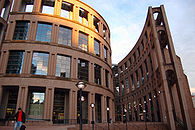
The study noted that the opportunities for such buildings were restricted due to a limited number of large development sites in the downtown.[122] Eight years later, five of the seven identified sites for higher buildings have been developed or are in the development application process. The tallest of these new buildings is the Living Shangri-La hotel/residential tower, which when completed in 2008 will stand 201 metres (659 ft)[123] tall (62 storeys).[124]
Arts and culture
- Further information: Music of Vancouver
Prominent theatre companies in Vancouver include the Arts Club Theatre Company on Granville Island, the Vancouver Playhouse Theatre Company, and Bard on the Beach. Smaller companies include Touchstone Theatre, Studio 58, Carousel Theatre, and the United Players of Vancouver. Theatre Under the Stars produces shows in the summer at Malkin Bowl in Stanley Park. In addition, Vancouver holds an annual Fringe Festival and International Film Festival.
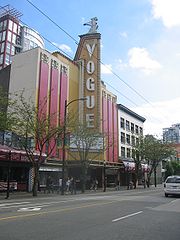
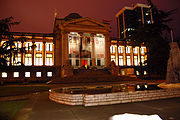
Vancouver is the home to museums and galleries. The Vancouver Art Gallery has a permanent collection of over 7,900 items valued at over $100 million and is the home of a significant number of works by Emily Carr.[125] In the Kitsilano district are the Vancouver Maritime Museum, and the H. R. MacMillan Space Centre. The Museum of Anthropology at UBC is a leading museum of Pacific Northwest Coast First Nations culture, and the Vancouver Museum is the largest civic museum in Canada. A more interactive museum is Science World.
In 1986, Greater Vancouver's cultural community created the Alliance for Arts and Culture to provide a strong voice for the sector and an avenue to work together. This coalition now numbers more than 320 arts groups and individuals. The Alliance's mission is to "strive towards an environment that recognizes, respects, and responds to the contribution our sector makes to society's well-being."[126]
Vancouver is a major regional centre for the development of Canadian music. The city's musical contributions include performers of classical, folk and popular music. The Vancouver Symphony Orchestra is the professional orchestra based in the city. It is also home to a major opera company, the Vancouver Opera, and numerous regional opera companies throughout the metropolitan area.
The city produced a number of notable punk rock bands, the most famous example being pioneering hardcore band D.O.A., whose enduring prominence in the city was such that Mayor Larry Campbell declared 21 December 2003 "D.O.A. Day" in honour of the band's 25th anniversary.[127] Other notable early punk bands from Vancouver included the Subhumans, the Young Canadians, the Pointed Sticks, Active Dog, The Modernettes, UJ3RK5, I, Braineater, and Nomeansno (originally from Victoria). The punk film Terminal City Ricochet was filmed in Vancouver; its title comes from an ice hockey team called the Terminal City Ricochets.[128]
When alternative rock hit the mainstream in the 1990s, several Vancouver groups rose to prominence, including 54-40, Odds, Moist, the Matthew Good Band and Econoline Crush, while recent successes include Gob and Stabilo. Today, Vancouver is home to a lively independent music scene, including bands such as The New Pornographers, Destroyer, Frog Eyes, The Organ, Veda Hille and Black Mountain; notable independent labels based in the city include Nettwerk and Mint. Vancouver also produced influential metal band Strapping Young Lad and pioneering electro-industrial bands Skinny Puppy and Front Line Assembly; the latter's Bill Leeb is better known for founding ambient pop super-group Delerium. Other popular musical artists who made their mark from Vancouver include Bryan Adams, Sarah McLachlan, Michael Buble, Nickelback, Heart (band), Diana Krall, Prism, Trooper, Chilliwack, Loverboy, Payola$, Images In Vogue, The Grapes of Wrath and Spirit of the West.[129] Notable hip hop artists from Vancouver include the Rascalz, Swollen Members, and Sweatshop Union.
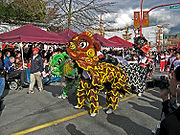
Larger performances are usually held at venues such as GM Place, Queen Elizabeth Theatre, BC Place Stadium or the Pacific Coliseum, while smaller acts are held at places such as the Plaza of Nations, the Commodore Ballroom, the Orpheum Theatre and the Vogue Theatre (currently closed). The Vancouver Folk Music Festival and the Vancouver International Jazz Festival showcase music in their respective genres from around the world.
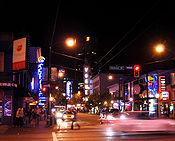
Vancouver's large Chinese population has a significant music scene, which has produced several Cantopop stars. Similarly, various Indo-Canadian artists and actors have a profile in Bollywood or other aspects of India's entertainment industry.
Nightlife in Vancouver had, for years, been seen as restricted in comparison to other cities, with early closing times for bars and night clubs, and a reluctance by authorities to allow for further development. However, since 2003 Vancouver has experimented with later closing hours and relaxed regulations, and an effort has been made to develop the Downtown core further as an entertainment district, especially on and around Granville Street.[130]
Sports and recreation
The mild climate of the city and close proximity to ocean, mountains, rivers and lakes make the area a popular destination for outdoor recreation. Indeed, Vancouver has a low adult obesity rate of 12% compared to the Canadian average, 23%; however, while 51% of Vancouverites are considered overweight, it is the fourth thinnest city in Canada after Toronto, Montreal, and Halifax.[131][132]


Vancouver has over 1,298 hectares (3,200 acres) of parks, with Stanley Park being the largest at 404 hectares (1,000 acres).[133] The municipality also has several large beaches, many adjacent to one another, with the largest groups extending from the coast of Stanley Park before reaching False Creek, and on the other side of English Bay, starting in the Kitsilano neighbourhood all the way to the University Endowment Lands, which are separate from Vancouver. The 18 kilometres (11 miles) of beaches that surround Vancouver include English Bay (First Beach), Jericho, Kitsilano Beach, Locarno, Second Beach (Stanley Park), Spanish Bank East, Spanish Bank Extension, Spanish Bank West, Sunset, and Third Beach (Stanley Park).[134] The coastline provides for many types of water sport, and the city is a popular destination for boating enthusiasts.
The nearby North Shore Mountains are home to three ski areas, Cypress Mountain, Grouse Mountain, and Mount Seymour. Each are within 20 to 30 minutes (driving time) of downtown Vancouver. Mountain bikers have created world-renowned trails across the North Shore. The Capilano River, Lynn Creek, Seymour River, within 20 minutes (driving time) of downtown, provide opportunities to whitewater enthusiasts during periods of rain and spring melt.
Running races include the Vancouver Sun Run (a 10 km race) every April; the Vancouver Marathon is held every May and Scotiabank Vancouver Half-Marathon held every June.
Vancouver will be the host city for the 2010 Winter Olympic and Paralympic Games and the 2009 World Police and Fire Games. Swangard Stadium, in nearby Burnaby, hosted some games for the 2007 FIFA U-20 World Cup.
Vancouver is exploring a joint bid for Vancouver and Seattle to host the 2028 Summer Olympics. A multi-national bid would be a first for the Olympics as an International Olympic Committee rule currently requires that the Olympics be awarded to a single city. Vancouver and Seattle both believe that the logistics can be overcome and have cited that the travel time between Seattle and Vancouver is similar to the travel time between Whistler, British Columbia and Vancouver.
Vancouver is home to the Vancouver Ultimate League[3], an Ultimate Frisbee league. In Summer 2008 Vancouver hosted the World Ultimate Championships.[135]
Professional sports teams
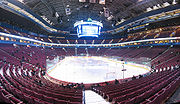
| Club | Sport | League | Venue |
|---|---|---|---|
| Vancouver Canucks | Ice hockey | National Hockey League | General Motors Place |
| BC Lions | Football | Canadian Football League | BC Place Stadium |
| Vancouver Canadians | Baseball (Single A Short Season) | Northwest League | Nat Bailey Stadium |
| Vancouver Whitecaps FC | Soccer | USL First Division (men's) W-League (women's) |
Swangard Stadium |
| Vancouver Giants | Ice hockey | Western Hockey League | Pacific Coliseum |
Media
Vancouver is the centre of the province's news media, with most national media chains having an office in the city.
English-language media
Both of the city's major daily newspapers, The Vancouver Sun and The Province, are published by the Pacific Newspaper Group Inc. In recent years, The Globe and Mail, a national newspaper based in Toronto, has added a section for local content in an effort to improve its circulation in Vancouver.
Other mainstream newspapers include the free 24 Hours, Metro, the twice-a-week Vancouver Courier, and the Westender. Independent newspapers include The Georgia Straight (a weekly), Xtra West, The Republic and Only.
Television stations include CBC, Citytv, CTV and Global TV. Radio stations with news departments include CBC Radio One, CKNW and CKWX.
Multicultural media
The diverse ethnic make-up of Vancouver's population supports a rich range of multicultural media.
There are three Chinese-language dailies: Ming Pao, Sing Tao and World Journal.
Television station OMNI British Columbia produces daily newscasts in Cantonese, Mandarin, Punjabi and Korean, and weekly newscasts in Tagalog. OMNI also produces programs aimed at other cultural groups. Fairchild Group also has two television stations: Fairchild TV and Talentvision, serving Cantonese and Mandarin speaking audiences respectively.
The Franco-Columbian community is served by Radio-Canada outlets CBUFT channel 26 (Télévision de Radio-Canada), CBUF-FM 97.7 (Première Chaîne) and CBUX-FM 90.9 (Espace musique).
Vancouver is also home to British Columbia's longest running Ukrainian radio program, Nash Holos.
Affiliated cities and municipalities
The City of Vancouver was one of the first cities in Canada to enter into an international twinning arrangement.[136] Special arrangements for cultural, social and economic benefits have been created with these sister cities.[137][58] These sister cities are:
| Country | City | Subdivision | Date |
|---|---|---|---|
| Odessa | Odessa | 1944 | |
| Yokohama | Kanagawa | 1965 | |
| Edinburgh | Scotland | 1978 | |
| Guangzhou | Guangdong | 1985 | |
| Los Angeles | California | 1986 | |
| Seoul | 2007 |
There are 21 municipalities in Metro Vancouver. While each of these has a separate municipal government, the Metro government oversees common services within the metropolitan area such as water, sewage, transportation, and regional parks.
See also
- List of people from Vancouver
- Vancouverism
References
- ↑ http://www.vancouverhistory.ca/archives_coevorden.htm
- ↑ "Municipal Population Estimates 2007" (PDF). Province of British Columbia Statistics Canada. Retrieved on 2007-12-01.
- ↑ 3.0 3.1 "Province of British Columbia and Greater Vancouver Transit Authority (TransLink) Facts 2008" (PDF). Government of Canada. Retrieved on 2007-12-01.
- ↑ "Population of census metropolitan areas (2001 Census boundaries)". Statistics Canada. Retrieved on 2006-09-15.
- ↑ "2006 Census: Population by mother tongue - cities". Retrieved on 2007-12-17.
- ↑ "City Facts 2004" (PDF). City of Vancouver. Retrieved on 2006-11-11.
- ↑ "2006 Census: Population by mother tongue - Metro regions". Retrieved on 2007-12-17.
- ↑ Stevens, Leah (January 1936). "Rise of the Port of Vancouver, British Columbia". Economic Geography (Clark University) 12 (1): 61–70. doi:. http://links.jstor.org/sici?sici=0013-0095%28193601%2912%3A1%3C61%3AROTPOV%3E2.0.CO%3B2-R. Retrieved on 2007-01-17.
- ↑ "Port Facts". Port of Vancouver. Retrieved on 2007-01-17.
- ↑ "Overnight visitors to Greater Vancouver by volume, monthly and annual basis" (PDF). Vancouver Convention and Visitors Bureau. Retrieved on 2006-11-16.
- ↑ "Key Sectors". Vancouver Economic Development Commission. Retrieved on 2006-11-11.
- ↑ "Industry Profile". BC Film Commission. Retrieved on 2006-12-24.
- ↑ "Vancouver Film Industry". Vancouver.com. Retrieved on 2006-12-24.
- ↑ Gasher, Mike (November 2002). Hollywood North: The Feature Film Industry in British Columbia. Vancouver: University of British Columbia Press. ISBN 077-4809-67-1.
- ↑ "Vancouver and Melbourne top city league", BBC News (4 October 2002). Retrieved on 2006-11-14.
- ↑ "Vancouver is 'best place to live'", BBC News (4 October 2005). Retrieved on 2007-01-17.
- ↑ "Vancouver world's second-best place to live: survey", CBC News (3 March 2003). Retrieved on 2007-09-01.
- ↑ "Readers Choice Awards 2005". Condé Nast Traveler. Retrieved on 2006-11-23.
- ↑ "Vancouver leads Canadian cities in world survey". CBC.ca. Retrieved on 2007-04-02.
- ↑ Expensive cities: The global cost of living. Interactive map. CBC.ca. Retrieved: 2007-06-19.
- ↑ Woolsey, Matt (2007-08-24). "World's Most Overpriced Real Estate Markets". Forbes.com.
- ↑ Woolsey, Matt (2007-08-24). "In Pictures: World's Most Overpriced Real Estate Markets". Forbes.com.
- ↑ Beauchesne, Eric (24 June 2006). "Toronto pegged as priciest place to live in Canada", CanWest News Service. Retrieved on 2006-11-23.
- ↑ Malone, Robert (2007-04-16). "Which Are The World's Cleanest Cities?". Forbes.com.
- ↑ "Vancouver 2010 Election". International Olympic Committee. Retrieved on 2007-01-17.
- ↑ "Vancouver 2010". Vancouver Organizing Committee for the 2010 Olympic Games. Retrieved on 2007-01-27.
- ↑ "Vancouver to host 2010 Winter Olympics", BBC (2003-07-18). Retrieved on 2007-01-17.
- ↑ Thom, Brian (1996). "Stó:lo Culture - Ideas of Prehistory and Changing Cultural Relationships to the Land and Environment". Retrieved on 2006-11-23.
- ↑ Davis, Chuck; Roy Carlson (1997). Greater Vancouver Book: An Urban Encyclopaedia. Surrey, BC: Linkman Press. pp. 31. ISBN 978-1896846002. http://www.discovervancouver.com/GVB/vancouver-archaeology.asp.
- ↑ Barman, Jean: "Stanley Park Secret's", page 21. Habour Publishing, 2005
- ↑ Davis, Chuck; W. Kaye Lamb (1997). Greater Vancouver Book: An Urban Encyclopaedia. Surrey, BC: Linkman Press. pp. 34–36. ISBN 978-1896846002. http://www.discovervancouver.com/GVB/captain-george-vancouver.asp.
- ↑ Smedman, Lisa (March, 03, 2006). "History of Naming Vancouver's Streets: Hamilton's Legacy", Vancouver Courier. Retrieved on 2007-08-05.
- ↑ "History of City of Vancouver". Caroun.com. Retrieved on 2007-01-17.
- ↑ 34.0 34.1 Hull, Raymond; Soules, Gordon, Soules, Christine (1974). Vancouver's Past. Seattle: University of Washington Press. ISBN 978-0295953649.
- ↑ McGowan's War, Donald J. Hauka
- ↑ Early Vancouver, Maj. J.S. "Skit" Mathews
- ↑ 37.0 37.1 37.2 37.3 Davis, Chuck (1997). The Greater Vancouver Book: An Urban Encyclopaedia. Surrey, British Columbia: Linkman Press. pp. 39–47. ISBN 978-1896846002. http://www.discovervancouver.com/gvb/history-of-vancouver.asp.
- ↑ 38.0 38.1 38.2 Cranny, Michael; Jarvis, Moles, Seney (1999). Horizons: Canada Moves West. Scarborough, ON: Prentice Hall Ginn Canada. ISBN 9780130123671.
- ↑ "Gastown.org - History". Retrieved on 2006-10-05.
- ↑ Davis, Chuck; Richard von Kleist (1997). Greater Vancouver Book: An Urban Encyclopaedia. Surrey, BC: Linkman Press. pp. 780. ISBN 978-1896846002.
- ↑ "Our History: Acquisitions, Retail, Woodward's Stores Limited". Hudson's Bay Company. Retrieved on 2007-01-23.
- ↑ McCandless, R. C. (1974). "Vancouver's 'Red Menace' of 1935: The Waterfront Situation". BC Studies (22): 68.
- ↑ Phillips, Paul A. (1967). No Power Greater: A Century of Labour in British Columbia. Vancouver: BC Federation of Labour/Boag Foundation. pp. 39–41.
- ↑ Phillips, Paul A. (1967). No Power Greater: A Century of Labour in British Columbia. Vancouver: BC Federation of Labour/Boag Foundation. pp. 71–74.
- ↑ Manley, John (1994). "Canadian Communists, Revolutionary Unionism, and the 'Third Period': The Workers' Unity League," (PDF). Journal of the Canadian Historical Association, New Series 5: 167–194. http://www.erudit.org/revue/jcha/1994/v5/n1/031078ar.pdf.
- ↑ Brown, Lorne (1987). When Freedom was Lost: The Unemployed, the Agitator, and the State. Montreal: Black Rose Books. ISBN 978-0920057773.
- ↑ Carved From Wood: A History of Mission 1861-1992, Andreas Schroeder, publ. Mission Foundation (1991), 227 pp., ASIN: B000WB9TWM
- ↑ Robin, Martin (1972). The Rush for Spoils: The Company Province,. Toronto: McClelland and Stewart. pp. 172. ISBN 0771076754.
- ↑ Robin, Martin (1972). The Rush for Spoils: The Company Province,. Toronto: McClelland and Stewart. pp. 187–188. ISBN 0771076754.
- ↑ Catherine Carstairs. "'Hop Heads' and 'Hypes':Drug Use, Regulation and Resistance in Canada," (PDF). University of Toronto.
- ↑ Francis, Daniel (2004). L.D.:Mayor Louis Taylor and the Rise of Vancouver. Vancouver: Arsenal Pulp Press. pp. 135. ISBN 1-55152-156-3.
- ↑ "Stanley Park, Vancouver Parks Board, 2006". City of Vancouver. Retrieved on 2006-11-07.
- ↑ Margaret E A North. "[? The Natural History of Richmond, British Columbia]". University of British Columbia.
- ↑ Environment Canada. "Lower Mainland Ecoregion" Narrative Descriptions of Terrestrial Ecozones and Ecoregions of Canada (#196). Retrieved on: 3 August 2007.
- ↑ "A Short History of Our Trees". Vancouver Cherry Blossom Festival. Retrieved on 2006-11-11.
- ↑ "Pacific Maritime Ecozone Pacific Maritime Ecozone". Environment Canada. Retrieved on 2006-11-14.
- ↑ "World66 - Vancouver Travel Guide". World 66. Retrieved on 2006-10-18.
- ↑ 58.0 58.1 58.2 58.3 "About Vancouver". City of Vancouver. Retrieved on 2007-01-17.
- ↑ "Weather Winners — Mildest Winters". Environment Canada. Retrieved on 2007-01-23.
- ↑ "Environment Canada data for Vancouver International Airport". Retrieved on 2008-10-01.
- ↑ 61.0 61.1 61.2 "Driving Lessons". Vancouver Magazine (June 2007). Retrieved on 2007-08-11.
- ↑ "Traffic entering Vancouver, 1986 to 2005". City of Vancouver. Retrieved on 2007-05-30.
- ↑ "City facts 2004" (PDF). City of Vancouver (2003).
- ↑ "Vancouver EcoDensity Initiative". Sam Sullivan. Retrieved on 2006-08-11.
- ↑ Thomas R. Berger (8 June 2004). "A City of Neighbourhoods: Report of the 2004 Vancouver Electoral Reform Commission" (PDF). City of Vancouver.
- ↑ Population by selected ethnic origins, by census metropolitan areas (2001 Census), Statistics Canada (2001).
- ↑ "Visible minorities (2001 census)". Statistics Canada. Retrieved on 2006-10-19.
- ↑ "Canada's ethnocultural portrait: Canada". Statistics Canada (2001). Retrieved on 2007-01-28.
- ↑ "Community Highlights for VancouverStatistics Canada (2001 census)". Statistics Canada ((2001 census data)). Retrieved on 2006-10-18.
- ↑ "Marriage for Same-Sex Couples in Ontario and British Columbia, Canada". Human Rights Campaign. Retrieved on 2006-11-28.
- ↑ "Sponsorship 2006" (PDF). Vancouver Pride Society. Retrieved on 2006-11-23.
- ↑ "City of Vancouver Population" (PDF). Vancouver Public Library. Retrieved on 2007-02-06.; "British Columbia Regional District and Municipal Census Populations" (PDF). BC Stats. Retrieved on 2007-04-21.; "British Columbia Municipal and Regional District 1996 Census Results". BC Stats. Retrieved on 2007-04-21.;"British Columbia Municipal and Regional District 2001 Census Results". BC Stats. Retrieved on 2007-04-21.;Davis, Chuck (1997). The Greater Vancouver Book: An Urban Encyclopedia. Surrey, BC: Linkman Press. pp. 780. ISBN 978-1896846002.
- ↑ "Port Facts". Vancouver Port Authority. Retrieved on 2007-01-15.
- ↑ "Why visit Vancouver?". Tourism Vancouver. Retrieved on 2006-11-11.
- ↑ Bula, Frances (January 22, 2007). "Vancouver is 13th least affordable city in world", Vancouver Sun.
- ↑ "Demographia International Housing Affordability Survey: 2006" (PDF). Wendell Cox Consultancy. Retrieved on 2006-11-12.
- ↑ "Housing Affordability" (PDF). RBC Financial Group. Retrieved on 2006-09-27.
- ↑ "Survey of Canadian Average House Prices in the First Quarter 2007" (PDF). Economics/Research. Royal LePage (29 March 2007). Retrieved on 2007-04-11.
- ↑ Real Estate Price Charts Blog, http://www.canadian-housing-price-charts.235.ca/charts.htm
- ↑ "For Many From Hong Kong, Vancouver Is a Way Station" (html). New York Times Hong Kong (14 February 1997). Retrieved on 2007-04-17.
- ↑ "Homelessness could triple by 2010: Report", CBC (21 September 2006).
- ↑ "Expo '86". The Canadian Encyclopedia. Historica. Retrieved on 2007-01-17.
- ↑ "Vancouver Charter". Queen's Printer (British Columbia). Retrieved on 2007-06-07.
- ↑ Andrea Barbara Smith. "The Origins of the NPA: A Study in Vancouver Politics". MA thesis. University of British Columbia.
- ↑ "Four Pillars Drug Strategy". City of Vancouver (2001). Retrieved on 2007-01-17.
- ↑ "From Grief to Action". From Grief to Action. Retrieved on 2006-11-15.
- ↑ Maxwell, Gillian. "Keeping the Door Open". AIDS Vancouver. Retrieved on 2006-11-15.
- ↑ "Vancouver Votes November 19, 2005". City of Vancouver. Retrieved on 2006-11-11.
- ↑ Police Services Division, Ministry of Public Safety and Solicitor General, Province of British Columbia (2006) Police and Crime: Summary Statistics: 1984–2005, pages 101, 106–110, 151, 154. ISSN 1198-9971
- ↑ "Welcome to "E" Division". Royal Canadian Mounted Police. Retrieved on 2007-11-01.
- ↑ "Beyond the Call" (PDF). Annual Report 2005. Vancouver Police Department (2005). Retrieved on 2006-11-23.
- ↑ "Vancouver Police Department Operating Results" (PDF). Vancouver Police Board (April 2005).
- ↑ "2005 Annual Report" (PDF). City of Vancouver (2005).
- ↑ "Mounted Squad: Patrol District One". Vancouver Police Department. Retrieved on 2007-01-17.
- ↑ "Police Operations". City of Vancouver. Retrieved on 2007-01-17.
- ↑ "Vancouver Police Board minutes of June 14, 2006" (PDF). City of Vancouver (June 2006). Retrieved on 2006-11-23.
- ↑ Howell, Mike (June 16, 2006). "VPD's war on terror 'requires a lot of legwork'". Vancouver Courier. Retrieved on 2006-11-23.
- ↑ "Vancouver Police Department Drug Policy" (PDF). Vancouver Police Department. Retrieved on 2006-11-23.
- ↑ "Growbusters", CBC (26 July 2000). Retrieved on 2007-01-17.
- ↑ Burrows, Mathew (21 February 2002). "Who You Gonna Call?", The Republic.
- ↑ 101.0 101.1 "Vancouver crime statistics". Statistics Canada. Retrieved on 2007-01-17.
- ↑ "Beyond the Call" (PDF). Annual Report 2005. Vancouver Police Department (2005).
- ↑ CBC News (2006-01-12). "Vancouver property crime down in 2005". Retrieved on 2006-09-01.
- ↑ "Beyond the Call" (PDF). Annual Report 2005. Vancouver Police Department (2005).
- ↑ Gun crime in Metro Vancouver highest per capita in Canada
- ↑ "200 Injured In Vancouver", New York Times (1994-06-16). Retrieved on 2008-07-14.
- ↑ Davis, Chuck. "The History of Metropolitan Vancouver". Retrieved on 2006-11-23.
- ↑ Davis, Chuck. "The History of Metropolitan Vancouver". Retrieved on 2006-11-14.
- ↑ Millar, Royce (2006-09-11). "No freeways puts Vancouver on top", The Age. Retrieved on 2006-11-14.
- ↑ "2006 Transportation Plan" (PDF). TransLink (December 2005). Retrieved on 2006-11-23.
- ↑ "District Review Report, School District No. 39 Vancouver" (PDF). British Columbia Education (June 2005). Retrieved on 2006-11-23.
- ↑ New Jersey university to open campus here, By Janet Steffenhagen, Vancouver Sun, B1, Published June 19, 2007
- ↑ Davis, Chuck; Harold Kalman (1997). Greater Vancouver Book: An Urban Encyclopaedia. Surrey, BC: Linkman Press. pp. 185–196. ISBN 978-1896846002. http://www.discovervancouver.com/GVB/notable-buildings.asp.
- ↑ Kalman, Harold (1974). Exploring Vancouver: Ten Tours of the City and its Buildings. Vancouver: University of British Columbia Press. pp. 160–161. ISBN 0774800283.
- ↑ Kalman, Harold (1974). Exploring Vancouver: Ten Tours of the City and its Buildings. Vancouver: University of British Columbia Press. pp. 22,24,78. ISBN 0774800283.
- ↑ "Marine Building". Archiseek. Retrieved on 2006-11-23.
- ↑ Davis, Chuck. "The History of Metropolitan Vancouver". Rattenbury. Vancouver History. Retrieved on 2006-11-23.
- ↑ 118.0 118.1 "Vancouver High-rise buildings (in feet)". Emporis Buildings. Retrieved on 2007-02-06.
- ↑ "Vancouver High-rise buildings". Emporis Buildings. Retrieved on 2006-11-23.
- ↑ "Vancouverism: Definitions Vancouverism". Canadian Architect. Retrieved on 2007-05-17.
- ↑ "Downtown Vancouver Skyline Study" (PDF). Special Council Meeting Minutes. City of Vancouver (7 and 23 April 1997).
- ↑ "General Policy for Higher Buildings" (PDF). City of Vancouver (6 May 1997).
- ↑ "Vancouver High-rise buildings (in feet)". Emporis Buildings. Retrieved on 2007-02-06.
- ↑ "Living Shangri-La, Vancouver". Emporis Buildings. Retrieved on 2008-03-13.
- ↑ "Welcome from Kathleen Bartels, Director of the Vancouver Art Gallery". Vancouver Art Gallery. Retrieved on 2007-11-01.
- ↑ "Mission and Priorities". Alliance for Arts and Culture. Retrieved on 2006-11-23.
- ↑ John Lucas. "D.O.A.’s punk veterans won’t give up the fight". The Georgia Straight. Retrieved on 2007-05-20.
- ↑ Buium, Greg (15 April 2005). "Sound and Fury: Reliving Vancouver’s punk explosion", CBC. Retrieved on 2007-01-23.
- ↑ Gooch, Bryan N. S.. "Vancouver, BC:1945–91". The Canadian Encyclopedia. Historica. Retrieved on 2006-11-23.
- ↑ "Police take aim at Vancouver's entertainment district", CBC (7 November 2006). Retrieved on 2007-01-23.
- ↑ "Regional differences in obesity". Health Reports. Statistics Canada (22 August 2006). Retrieved on 2007-01-23.
- ↑ Kirkey, Sharon (2006-08-23). "Suburban Sprawl", CanWest News Service. Retrieved on 2006-11-23.
- ↑ "About the Park Board". Vancouver Board of Parks and Recreation. Retrieved on 2007-01-15.
- ↑ Thomas, Sandra (19 May 2006). "City gets into the swim of things", Vancouver Courier. Retrieved on 2007-01-15.
- ↑ "WFDF 2008 World Ultimate & Guts Championships". Retrieved on 2008-08-02.
- ↑ Smith, Patrick J. and Kennedy Stewart. "Beavers and Cats Revisited: Creatures and Tenants versus Municipal Charter(s) and Home Rule" (PDF). Institute of Intergovernmental Relations, Queen's University. Retrieved on 2007-01-23. Archived at www.archive.org. Retrieved on 2008-08-06.
- ↑ "Vancouver Twinning Relationships" (PDF). City of Vancouver. Retrieved on 2008-10-30.
External links
- Official website - City of Vancouver
- Official Travel and Tourism Information - Tourism Vancouver
- Vancouver 2010 - Winter Olympic and Paralympic Games, Official Web Site
- Vancouver in the BC Geographical Names Information System
- Arts and Culture - Alliance for Arts and Culture
- Vancouver History Site - Chuck Davis
- Vancouver travel guide from Wikitravel
- Vancouver's Mountain Playground — Illustrated Historical Essay and movie clip (McCord Museum, Montreal)
Related Information
 |
West Vancouver | City of North Vancouver | District of North Vancouver |
|
|||
| University Endowment Lands | Burnaby New Westminster |
||||||
| Strait of Georgia | Richmond Delta |
Surrey |
|
||||||||||||||
|
||||||||||||||||
|
||||||||||||||||
|
|||||||||||||||||
|
|||||
|
|||||
|
|||||



